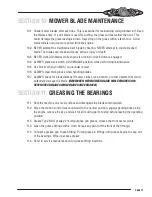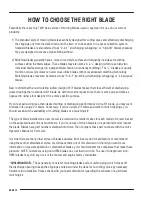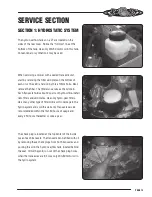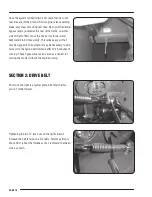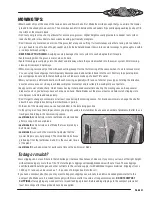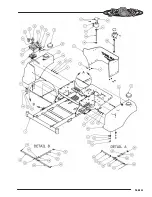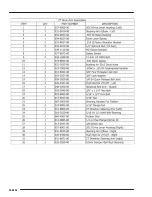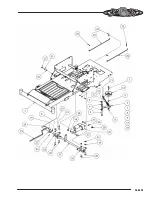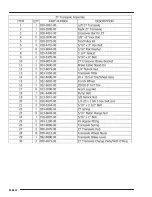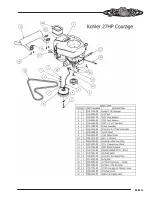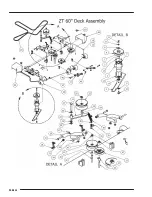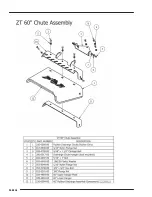
MOWING TIPS:
• Mow header strips at the ends of the lawn and around flower beds first. Make them wide enough that you can turn the mower
around in the already mown section. Then mow back and forth between these header strips overlapping each lap by about 1/8
the width of the mower’s deck.
• Don’t cut your grass too short, particular for cool season grasses. Higher heights usually provide for a deeper root system,
looks better, and is less likely to have weeds invading, particularly crabgrass.
• Don’t remove any more than one third of the grass leaf at any one cutting. If circumstances arise that a lawn gets too tall and
you just have to lop off a bunch to get caught up, bite the bullet and break it down into several mowings to get caught up with 3
or so days between cuttings.
•
NEVER SCALP YOUR LAWN. Scalping severely damages the root system to such a degree that it may die.
• Avoid mowing when the grass is wet or when it’s dark
• Avoid throwing grass clippings into the street and driveway where they can be washed into the sewer system. After mowing,
clean up driveway and walkways.
• When mowing remove only a third with each cutting (except for the first mowing of the season when it’s ok to remove more).
You can safely leave clippings that will quickly decompose and add nutrients back into the soil. Contrary to popular opinion,
grass clippings do not add to thatch buildup. Grass blades are made up of about 75% water.
• Mow your lawn in a different direction with each mowing, especially with lawns of shorter grass types. Altering the direction
ensures a more even cut since grass blades will grow more erect and less likely to develop into a set pattern.
• Keep your mower’s blade sharp, which means having it sharpened several times during the mowing season. Keep several
blades around so you’ll always have a sharp one on hand. Sharp blades cut the grass cleanly and help mulch clippings into
small pieces which break down quickly.
• Don’t forget to change your mower’s oil at least once during the mowing season. For brand new mowers, change the oil after
about 5 hours of operation during the initial break-in period.
• At the end of the mowing season use a fuel stabilizer in the remaining gasoline
• In the spring, don’t use that old gas unless you properly used a fuel stabilizer, it can cause a number of problems. Better to use
fresh gasoline to begin the new mowing season.
•
Leaf blade A demonstrates what a leaf blade should look like
after mowing with a sharp blade.
•
Leaf blade B demonstrates a leaf blade that was injured by a
dull mower blade.
•
Leaf blade C was cut by the mower but indicates that the
mower blade is not sharp enough. The shredded white tissue
protruding from the leaf blades C and D is the vascular tissue
of the plant.
•
Leaf blade D has been mown for quite some time with a dull mower blade.
To bag or mulch?
Grass clippings do not contribute to thatch buildup or increase the chances of disease. If you mow your lawn at the right height,
without removing any more than 1/3 of it’s total height, clippings will quickly breakdown without a trace. These clippings
contribute additional nitrogen and other nutrients to the soil and supply it with additional organic materials. Clippings from a
1000 sq. ft. lawn can add as much as 1 - 2 pounds of nitrogen back into the soil.
If you have a compost pile, then you may want to bag your clippings occasionally to add much needed green-matter to the
compost pile. Make sure it is mixed thoroughly with brown matter to avoid a strong ammonia odor.
DO NOT COMPOST
CLIPPINGS after applying any weed control or weed-feed type product. Before adding clippings to the compost pile wait at
least 3 mowings after these products have been applied.
PAGE 21
Summary of Contents for ZT ELITE
Page 17: ...PAGE 17...
Page 22: ...PARTS SECTION PAGE 22...
Page 23: ...PAGE 23...
Page 24: ...PAGE 24...
Page 25: ...PAGE 25...
Page 26: ...PAGE 26...
Page 27: ...PAGE 27...
Page 28: ...PAGE 28...
Page 29: ...PAGE 29...
Page 30: ...PAGE 30...
Page 31: ...PAGE 31...
Page 32: ...PAGE 32...
Page 33: ...PAGE 33...
Page 34: ...PAGE 34...
Page 35: ...PAGE 35...
Page 36: ...PAGE 36...
Page 37: ...PAGE 37...
Page 38: ...PAGE 38...





